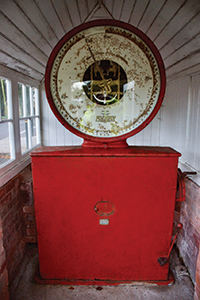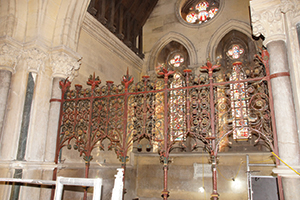The Historic Metalwork Conservation Company Ltd (HMCC) was established by Peter Meehan in 2011. The company was created to provide care and conservation advice for people in charge of the care, management and preservation of historic metalwork. The company provides advice on historic metalwork of many different forms and specialises in historic ironwork, which has previously lacked conservation specialists. Peter Meehan is a fully accredited conservator and is listed on the Institute of Conservation (ICON) Conservation Register.
Derived from its founder Peter’s passion and expertise, Peter is extremely familiar with working on historic metalwork and has over 35 years’ of experience.
Starting out, Peter studied Archaeological Conservation at University College Cardiff in the mid-1980’s and was awarded an Honours Science Degree.
Expanding his portfolio of experience, Peter went onto work in many reputable establishments, a few of which include the Ancients Monuments Laboratory for English Heritage, Museum of London, the British Museum – specialising in the conservation of metalwork – and the Science Museum. Peter has been fortunate to have worked on many important historic objects throughout his career and in 2011, he decided to set up his own consultancy business, bringing HMCC into fruition.
From small delicate pieces of jewellery, right up to bridges and motor cars; Peter is well-equipped with the knowledge and skills to advise on any sized project.
“We are a heritage consultancy company, who advises owners on the best way to look after, repair and store historic metalwork. I have a slight advantage in my services as I am an Accredited Conservator through the Institute of Conservation (ICON). This provides clients with confidence that they will receive professional, accredited advice and expert insights. This is particularly important when working on historic buildings/building sites as planning conditions do require an Accredited Conservator to survey, advise. Sometimes, I will carry out the work myself.” Peter stated.
HMCC’s primary aim is to provide specialist advice for people responsible for historic metalwork in both the public and private sectors. Through his services, Peter has assisted many different industries and clients including museum staff, heritage engineers, conservation architects, local authority conservation officers, historic building contractors and private individuals looking for professional solutions when dealing with conservation and restoration challenges.
 In terms of specific services, HMCC provides an array of professional services and is able to assist its clients, to help them to achieve the appropriate levels of preservation for their collections. These services include the preparation of condition surveys and reports, conservation specifications, conservation budgets, maintenance programmes and guidance on collections care and metals conservation.
In terms of specific services, HMCC provides an array of professional services and is able to assist its clients, to help them to achieve the appropriate levels of preservation for their collections. These services include the preparation of condition surveys and reports, conservation specifications, conservation budgets, maintenance programmes and guidance on collections care and metals conservation.
A notable recent project, HMCC was contacted by Donald Insall Architects, to carry out a survey on the transept screens, altar rail and wall lights at St Peter’s Church, Daylesford. St Peter’s church was originally designed by the Victorian architect, John Loughborough Pearson and was completed in 1863. Maintaining its original, gothic style, which features include two wrought iron transept screens complete with their original paint scheme, these features are believed to have been created by Francis Skidmore, a renowned craftsman and leading figure in the Gothic Revival Movement.
Peter was tasked with inspecting and preparing a report to recommend suitable conservation treatments. Assessing the ornate ironwork, peter deemed that the original paint was still mostly intact but had become dirty, with some losses due to localised iron corrosion which could possibly be linked to condensation during cold weather periods. The client instructed HMCC to carry out the conservation recommendations in the original report, to clean and stabilise the screens, altar rail and wall lights. This was done as part of improvements to the fabric of the church building. After delicately cleaning the ironwork, both by brush and vacuum, the paintwork was consolidated using a 5% solution of an acrylic resin dissolved in white spirit. The treated surface was then protected with a coating of Renaissance microcrystalline wax applied, using a soft brush. This process has helped to maintain and improve the metalwork’s original features and appearance, enabling more generations to appreciate the timeless beauty of the church’s historical metalwork features.
Speaking of the company’s future plans, HMCC is looking to expand its customer base and explore new markets in Europe. Peter stated that, “I will be looking into working in Europe now that we have left the EU, as it is now slightly easier to work there. I have recently been in contact with a restoration company in Portugal to assist them with their projects.”
For any more information on the company, please head to the company’s website. To speak to Peter directly, please give him a call on the number stated.
Contact
T 07883 205704
www.hm-cc.uk

